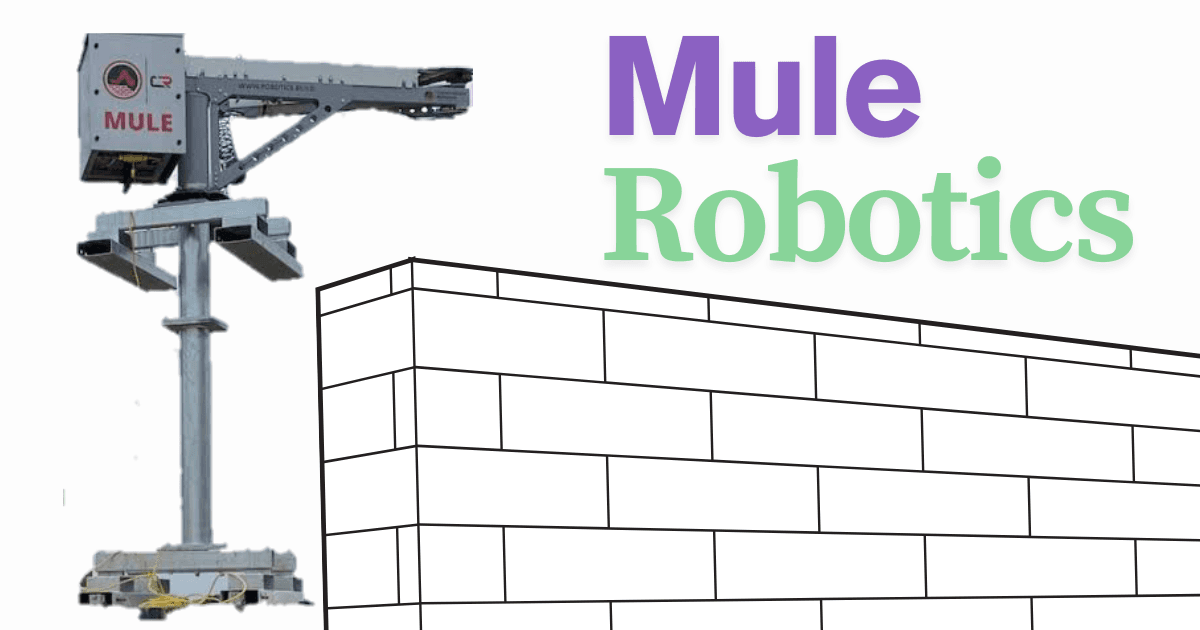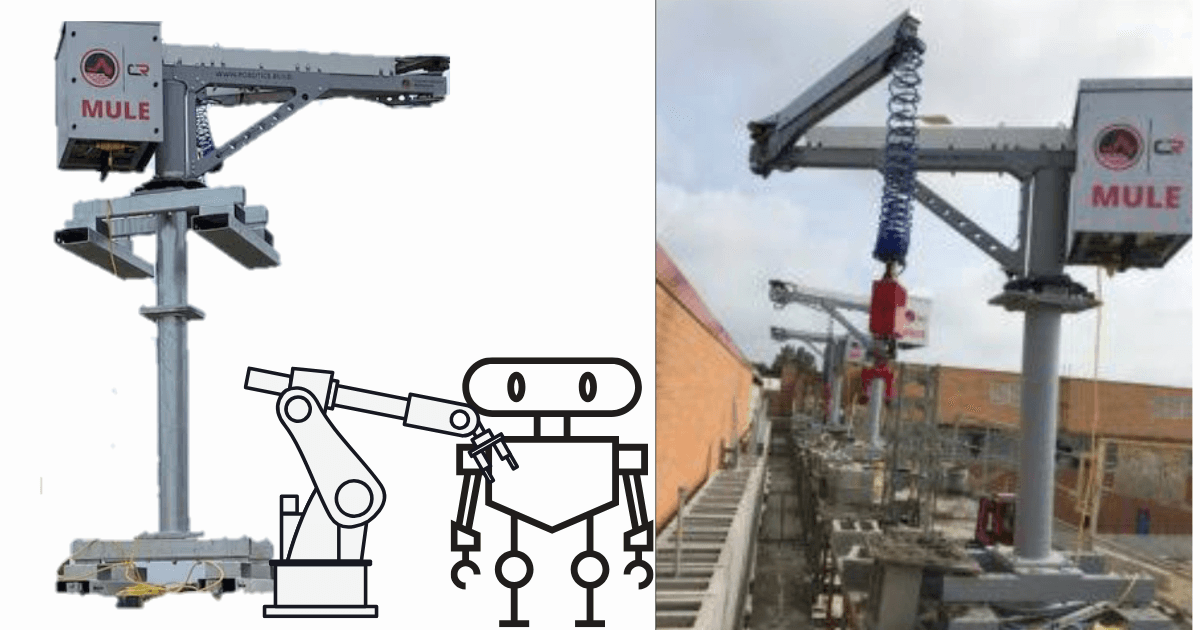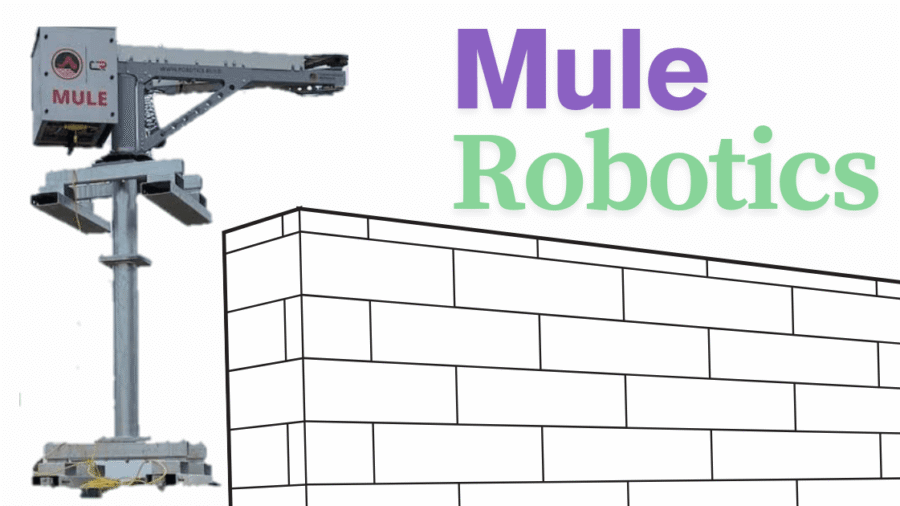
What is Mule Robotics?
At its core, Mule Robotics is a class of intelligent robotic systems
designed to augment human capabilities in heavy material handling,
particularly in construction and industrial settings. The term “MULE”
stands for Material Unit Lift Enhancer, and these systems are purpose built to assist with the lifting and positioning of large, heavy
construction blocks, especially concrete masonry units (CMUs).
The Rise of Mule Robotics in Construction the rapidly evolving world of construction, innovation isn’t just a buzz word—it’s a necessity. Labor shortages, rising project demands,and the physical toll on workers are pushing the industry toward smarter,more sustainable practices. Mule Robotics has emerged as atransformative force in this domain. Whether it’s lifting heavy blocks orautomating repetitive lifting tasks, Mule Robotics—through systems like the concrete mule, mule robot, and mule lift—is redefining what’spossible on the job site.
Key variants include:
Concrete Mule: Specializes in handling heavy concrete blocks.
Mule Robot: A robotic arm integrated with lifting assistance and
AI.
Mule Lift: A vertical lifting mechanism that works in sync with
construction teams.
Whether you’re operating on a small residential project or a massive
commercial build, Mule Robotics allows workers to do more, lift
smarter, and reduce fatigue-related injuries.
The Technology Behind Mule Robotics
What makes Mule Robotics so effective? It’s a sophisticated
combination of robotics, ergonomic engineering, and AI-enhanced
control systems. Let’s break it down:
- Robotic Arm Precision: The mule robot is built with precision
motors and sensors to detect weight distribution, grip strength, and
optimal placement angles. - AI Integration: Some mule lift models are integrated with
adaptive software that learns usage patterns and adjusts assistance
accordingly. - Operator Control: Despite being autonomous, Mule Robotics
systems often include manual override features, allowing workers
to guide movement with ease.
These technologies work in harmony to improve not only speed but also
safety, making Mule Robotics one of the most reliable co-workers you
can add to your team.
The Benefits of Mule Robotics in the Field
Why is Mule Robotics gaining such momentum? Let’s explore its top
benefits:
Injury Reduction
Musculoskeletal injuries are the most common hazard in construction.
With Mule Robotics, workers experience less strain on the back,
shoulders, and knees. A mule lift takes the weight off the human body,
redistributing it through its mechanical arms.
Labor Optimization
With fewer skilled masons available, contractors are under pressure.
Mule Robotics helps teams complete heavy lifting tasks faster and with
fewer people. This not only addresses labor shortages but enhances
productivity across the board.
Precision and Quality
The concrete mule delivers a consistent, accurate block placement,
leading to cleaner lines, better alignment, and higher structural integrity.
Scalability
Whether you rent a single mule robot or equip a fleet of them across
sites, the technology scales to match your project’s size and scope.
Concrete Mule: A Game-Changer in Masonry

Of all the tools under the Mule Robotics umbrella, the concrete mule
stands out for its industry-changing impact. Designed to lift and place
CMUs weighing up to 135 pounds, it allows a single worker to
accomplish what would traditionally require two or more.
Use Case Example:
On a typical site, a mason can place 90–110 CMUs per day. With a
concrete mule, that number can jump to 200+, effectively doubling
productivity while reducing injury risk.
Field Test Results:
According to data from Construction Robotics, projects that utilized the
concrete mule saw:
- 30% reduction in labor costs
- 50% increase in daily output
- 60% lower fatigue levels reported by workers
In short, the concrete mule is not just an assistant—it’s a competitive
advantage.
Mule Lift: Vertical Lifting Made Easy
A newer innovation in the Mule Robotics line is the mule lift, designed
for vertical material placement and precise alignment at various heights.
It features an extendable boom and smart positioning tech that keeps
blocks perfectly aligned even on uneven terrain.
Advantages of the Mule Lift:
- Perfect for high wall construction
- Easily transported across floors
- Can lift loads up to 150 lbs with zero swing or shift
The mule lift is revolutionizing how masons think about scaffolding,
reach, and height work—replacing risk with reliability.
Should we Rent a Mule? The Business Logic
You don’t always have to buy to reap the benefits. Many contractors
now rent a mule to minimize upfront investment. Here’s why that
makes business sense:
- Short-term flexibility: Try before committing long-term.
- Budget-friendly: Lower operational cost, no maintenance burden.
- Training included: Most rental services include basic training and support.
Top providers like Construction Robotics and MULE Rentals USA offer
flexible rental packages, allowing teams to rent a mule for a few days
or several months depending on project duration.
Real-World Case Studies: Mule Robotics in Action
To truly understand the power of Mule Robotics, we need to look at
real-world applications where these systems have delivered tangible
results. From skyscraper projects to school buildings and infrastructure
works, the mule robot is proving itself across sectors.
Case Study 1: Large-Scale Commercial Construction
In a high-rise construction project in Atlanta, Georgia, contractors
deployed 10 concrete mule units. The goal was to improve efficiency
and reduce labor dependence amid workforce shortages. The result?
- Daily block placement increased by 60%
- Labor costs dropped by 32%
- Worker compensation claims related to strain injuries fell to zero
The success led the company to rent a mule for all its ongoing builds
across the southeast region.
Case Study 2: School Expansion Project in Texas
A school district in Austin needed to expand two campuses in under six
months. Tight timelines and budget concerns made the use of mule lift
and mule robot technology a no-brainer.
- Crews lifted over 2,500 concrete blocks weekly
- Wall alignment accuracy exceeded 98%
- Completion time was cut by 28 days
In exit interviews, 87% of the workers said they would prefer using
Mule Robotics in future builds.
Mule Robotics vs. Traditional Labor: A Cost-Benefit Analysis
Metric
- Block Placement Rate
- Worker Fatigue
- Injury Risk
- Labor Needed
- Long-Term ROI
Traditional Labor
- 100-120/day
- High
- High (repetitive strain)
- 2-3 masons
- Limited
Mule Robotics
- 200-300/day
- Low
- Very Low
- 1 mason + mule
- High
Even when you rent a mule, your cost per square foot of masonry drops
significantly—especially when you account for fewer breaks, higher
accuracy, and near-zero rework rates.
Environmental and Sustainability Factors
In today’s eco-conscious world, the environmental impact of
construction tools and systems cannot be ignored. Here’s how Mule
Robotics aligns with sustainability goals:
Reduced Material Waste
With precise handling, concrete mule systems ensure accurate block
placements, reducing cracked or broken units.
Energy Efficiency
Modern mule robots are battery-operated and consume minimal power.
Unlike diesel-powered cranes or lifts, they produce zero emissions onsite.
Extended Career Lifespan for Workers
Less physical strain means that skilled workers can stay on the job
longer, reducing the turnover rate and improving overall workforce
sustainability.
Future of Mule Robotics: What’s Next?
The current generation of Mule Robotics has set a high benchmark, but
this is only the beginning. Here’s what we can expect in the near future:
AI-Driven Site Coordination
Imagine a network of mule robots working in sync with cranes, drones,
and autonomous forklifts. Integrated AI will allow Mule units to
communicate and coordinate with other smart devices for fully
automated workflows.
Advanced Material Handling
New models of mule lift are expected to handle not just CMUs but also
steel plates, timber panels, and prefabricated wall segments. This would
make Mule Robotics a central fixture across multiple trades.
Augmented Reality Integration
Masons wearing AR glasses could visualize exactly where to place each
block, while the mule robot positions it with surgical precision. This
fusion of physical and digital could be a game-changer.
Training & Adoption: How to Get Started with Mule Robotics
Worried about the learning curve? Don’t be. Mule Robotics is designed
for quick adoption:
- Training Time: Most workers become fully proficient in under 4 hours
- Support: Companies that rent a mule usually offer on-site support and maintenance
- Customization: Systems can be adapted for different block sizes and site layouts
Whether you’re a small contractor or a large developer, integrating Mule
Robotics can be as simple as scheduling a demo and booking your first
mule lift rental.
Mule Robotics: Revolutionizing Worksite Culture
One often overlooked benefit of Mule Robotics is the cultural shift it
brings to construction sites. Traditionally, masonry is known for being
labor-intensive and physically taxing. With Mule Robotics, that
perception is changing.
- Inclusivity: More women and older workers are joining the masonry field thanks to reduced lifting demands.
- Morale Boost: When workers see their productivity skyrocket without wearing themselves down, job satisfaction soars.
- Retention: Companies that use mule robots report higher retention rates and improved team dynamics.
These human-centered benefits are as valuable as the economic ones,
proving that Mule Robotics is about more than just machines—it’s
about making construction a more humane and future-ready industry.
Where to Rent a Mule Robot Today
If you’re ready to explore Mule Robotics for your next project, several
providers offer flexible rental options:
- Construction Robotics: Pioneers of the MULE system, offering nationwide rentals.
- Mule Rentals USA: Specializing in short-term and long-term contracts.
- Local Equipment Suppliers: Many regional suppliers now include concrete mule and mule lift systems in their offerings.
Costs vary based on location, duration, and quantity, but average pricing
ranges from $200–$300/day with training included.
Conclusion: Why Mule Robotics is the Future of Construction
After more than five decades of observing technological evolution
across construction, I can say without hesitation: Mule Robotics is one
of the most impactful developments of the 21st century.
From the rugged durability of the concrete mule, to the adaptability of
the mule lift, and the precision of the mule robot, these systems aren’t
just tools—they’re teammates. They lift more than blocks; they lift the
entire standard of modern masonry.
And whether you’re a construction veteran or a startup builder, the
decision to rent a mule could be your smartest investment yet.
Embrace the change. Empower your team. Let Mule Robotics do the
heavy lifting—literally and figurative.
read more:
Robot Cart : Amazing Tool To Transform Industries In 2024.
Germanium Transistor: Loaded with Mesmerizing features for 21st century.
How do drone shows work? It’s Cost and technology behind this wonder.
What is the future of RPA developer? : Robotic Process Automation in 2025
RUST : BEST LANGUAGE FOR ROBOTICS in 2025?
10 Reasons Why I Love Robotics
The Future of AI: Top 7 Latest AI developments
What is Mule Robotics and what is its primary function?
Mule Robotics refers to robotic systems designed to function like a mechanical pack mule capable of transporting heavy loads across rough or remote terrain. These robots are primarily used in military, agriculture, and industrial logistics to support humans by reducing physical burden and increasing efficiency in transporting goods.
Where are Mule Robots currently being deployed?
Military missions for carrying supplies and ammunition, Farms for transporting tools, crops, or feed across fields.
Disaster zones to deliver aid, medical supplies, or equipment in areas inaccessible to
humans or vehicles. Construction sites where material movement can be automated.
What technologies power modern Mule Robotics systems?
Modern Mule Robots are powered by:
AI and machine learning for route planning and obstacle detection
GPS and LIDAR for autonomous navigation
Sensor arrays for real-time feedback and environment interaction
What are the advantages of using Mule Robotics in critical missions?
Reduced human workload and risk, (especially in hostile environments)
High payload capacity, Terrain adaptability (from rocky slopes to muddy fields) Reliability(often with robust design for long-term use) are some advantages of mule robotics in critical missions.



